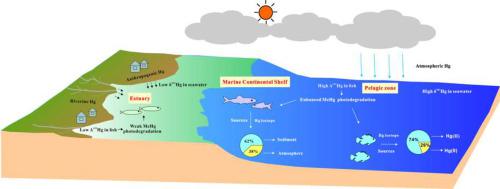Water Research ( IF 12.8 ) Pub Date : 2023-05-30 , DOI: 10.1016/j.watres.2023.120150 Shaochen Yang 1 , Ping Li 2 , Kaifeng Sun 3 , Nan Wei 3 , Jinling Liu 1 , Xinbin Feng 2

|
Anthropogenic activities and climate change have significantly increased mercury (Hg) levels in seawater. However, the processes and sources of Hg in differing marine compartments (e.g. estuary, marine continental shelf (MCS) or pelagic area) have not been well studied, which makes it difficult to understand Hg cycling in marine ecosystems. To address this issue, the total Hg (THg) concentration, methylmercury (MeHg) concentration and stable Hg isotopes were determined in seawater and fish samples collected from differing marine compartments of the South China Sea (SCS). The results showed that the estuarine seawater exhibited substantially higher THg and MeHg concentrations than those in the MCS and pelagic seawater. Significantly negative δ202Hg (−1.63‰ ± 0.42‰) in estuarine seawater compared with that in pelagic seawater (−0.58‰ ± 0.08‰) may suggest watershed input and domestic sewage discharge of Hg in the estuarine compartment. The Δ199Hg value in estuarine fish (0.39‰ ± 0.35‰) was obviously lower than that in MCS (1.10‰ ± 0.54‰) and pelagic fish (1.15‰ ± 0.46‰), which showed that relatively little MeHg photodegradation occurred in the estuarine compartment. The Hg isotope binary mixing model based on Δ200Hg revealed that approximately 74% MeHg in pelagic fish is derived from atmospheric Hg(II) deposition, and over 60% MeHg in MCS fish is derived from sediments. MeHg sources for estuarine fish may be highly complex (e.g. sediment or riverine/atmospheric input) and further investigations are warranted to clarify the contribution of each source. Our study showed that Hg stable isotopes in seawater and marine fish can be used to identify the processes and sources of Hg in different marine compartments. This finding is of great relevance to the development of marine Hg food web models and the management of Hg in fish.
中文翻译:

海水和海洋鱼类中的汞同位素组成揭示了不同海洋区域食物网中汞的来源和过程
人类活动和气候变化显着增加了海水中的汞 (Hg) 含量。然而,不同海洋区划(例如河口、海洋大陆架(MCS)或远洋区域)中汞的过程和来源尚未得到充分研究,这使得了解海洋生态系统中的汞循环变得困难。为了解决这个问题,我们测定了从南海不同海域采集的海水和鱼类样本中的总汞 (THg) 浓度、甲基汞 (MeHg) 浓度和稳定汞同位素。结果表明,河口海水的 THg 和 MeHg 浓度显着高于 MCS 和中上层海水。显着负 δ 202河口海水中的汞(−1.63‰±0.42‰)与中上层海水中的汞(−0.58‰±0.08‰)相比,可以提示河口区划流域的汞输入和生活污水排放。河口鱼类的Δ 199 Hg 值(0.39‰±0.35‰)明显低于MCS(1.10‰±0.54‰)和中上层鱼类(1.15‰±0.46‰),表明河口鱼类中的甲基汞光降解相对较少。河口隔室。基于Δ200的Hg同位素二元混合模型汞显示,中上层鱼类中大约 74% 的甲基汞来自于大气汞(II)沉积,而 MCS 鱼类中超过 60% 的甲基汞来自于沉积物。河口鱼类的甲基汞来源可能非常复杂(例如沉积物或河流/大气输入),需要进一步调查以澄清每个来源的贡献。我们的研究表明,海水和海鱼中的汞稳定同位素可用于识别不同海洋区划中汞的过程和来源。这一发现对于海洋汞食物网模型的开发和鱼类汞的管理具有重要意义。


























 京公网安备 11010802027423号
京公网安备 11010802027423号